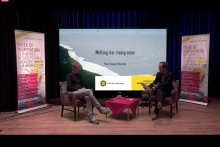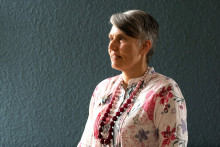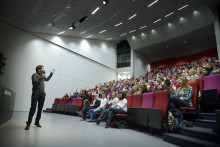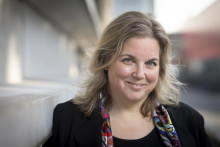With a master in physics and a PhD in snow, ice and solar radiation, Kuipers Munneke is a professional on the topic. He has even encountered several polar bears while going on expeditions to place weather stations on ice sheets in the Arctic. In his talk, Kuipers Munneke showed how these stations are placed, and what they can track. As you might expect, the received data is not positive: ice sheets are indeed melting.
Glaciers, ice cubes and ice sheets
Kuipers Munneke, also a glaciologist at Utrecht University, started with a worrisome illustration. ‘In Enschede we are 10 meters above sea level. A pretty save and dry spot, you would say. But if the ice sheets were to melt, all of Enschede might look like Het Torentje van Drienerlo: water will be up to 55 meters above sea level.’
He followed up on that statement by explaining how it can be possible that our water level would rise this much. Kuipers Munneke described how the speed of sea level rising has doubled over the last hundred years. ‘It is accelerating, and fast. Half of this is due to the melting of ice caps, and the other half to the thermal warming of the ocean.’ He used an image to explain how much the sea level will rise. ‘If all glaciers were to melt, the water level would rise by 0.40 meter. These glaciers can be found in countries near us, such as in Switzerland, where we can already see big changes happening. But, this is nothing compared to Greenland and Antarctica. If these sheets were to melt, we would be in big trouble.’

Screenshot of yesterday evening's presentation.
Predicting, forcing and contributing to change
To stop these sheets from melting, a lot of research goes into tracking the ice caps. Recently a new Sentinel 6 satellite has been launched into space to better monitor the sea level, and all over the ice caps weather stations can be found. ‘But,’ says Kuipers Munneke, ‘Even if we manage to predict how much the sea level is going to rise, this number will be uncertain.’ He compares the research to a three stage rocket:
Stage 1: We are not sure if we are going to be able to stop the emission of C02.
Stage 2: Suppose the levels increase a bit more, how much warmer will it be on earth? We are not sure.
Stage 3: Suppose we know that we will have 2 degrees of warming, how are the ice sheets going to respond? We have a good estimation, but we are not certain.
Lifestyle change
During the talk, viewers could also ask live questions. For instance, someone was wondering how Kuipers Munneke acts on climate change himself. He explained how he had a vision three years ago. He was studying the results of climate changes, but did not adapt his lifestyle to leave a smaller carbon footprint. If anything, it was only bigger because he had to fly everywhere for his job. After he had this vision, he set a challenge for himself to travel as climate neutral as possible by compensating flights and taking trains where he could have taken a taxi. In addition to this, he became a vegetarian.
If you are interested to hear how Sentinel 6 keeps track of ice sheets using gravity forces, where Kuipers Munneke encountered polar bears or about which ice cap we should worry more (Greenland or Antarctica), you can watch the recording of this talk here.







